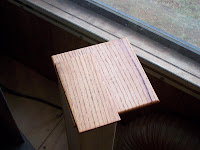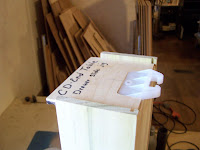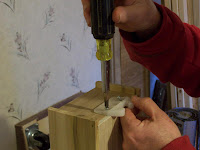 Upon my return I brought the new boards in and began building the base of the crate. Like so many things people build, a good foundation is important if the crate is to protect Nance’s CD End Table all the way to Texas.
Upon my return I brought the new boards in and began building the base of the crate. Like so many things people build, a good foundation is important if the crate is to protect Nance’s CD End Table all the way to Texas.  All our crates incorporate a pallet style base with cut-outs that allow a floor jack or fork lift to get under it and lift. The base itself uses two layers of wood, the outer layer provides most of the strength and a lip for the side panels to hook into, the inner layer offers a lip for the floor of the crate to sit on.
All our crates incorporate a pallet style base with cut-outs that allow a floor jack or fork lift to get under it and lift. The base itself uses two layers of wood, the outer layer provides most of the strength and a lip for the side panels to hook into, the inner layer offers a lip for the floor of the crate to sit on.When we start a crate Marie often admonishes me with, “It’s JUST a crate, not a piece of furniture, don’t make yourself crazy over it.” And I try, I really do, but I find myself fussing over things anyway. Oh, well.
 Once the base is completed and squared up I bring crate board in from the big shed. This stuff is ½ inch thick, triple layer corrugated cardboard that we get from International Paper in Morristown TN. It offers the same puncture resistance and vertical crush resistance as the ¼’ luan plywood we used to use but is considerably lighter than plywood, less expensive and easier to work with to boot. Plus, being cardboard it recycles easily. There is no down side. What I’m working with here are actually scraps from the last project we shipped. This crate board comes in 9 foot by 16 foot panels which can be a bit tricky to handle in confined spaces. These smaller “scraps” are much easier to work with, yet are plenty big enough to get the pieces I need out of.
Once the base is completed and squared up I bring crate board in from the big shed. This stuff is ½ inch thick, triple layer corrugated cardboard that we get from International Paper in Morristown TN. It offers the same puncture resistance and vertical crush resistance as the ¼’ luan plywood we used to use but is considerably lighter than plywood, less expensive and easier to work with to boot. Plus, being cardboard it recycles easily. There is no down side. What I’m working with here are actually scraps from the last project we shipped. This crate board comes in 9 foot by 16 foot panels which can be a bit tricky to handle in confined spaces. These smaller “scraps” are much easier to work with, yet are plenty big enough to get the pieces I need out of. For anyone who wants to try crateboard in their shipping here are a couple of tips:
For anyone who wants to try crateboard in their shipping here are a couple of tips:1) A drywaller’s square (that big blue T-square) helps a lot in laying out good square panels.
2) Use a good utility knife with replaceable blade, and replace the blades often. Paper dulls a knife blade faster than you might believe and a dull blade make for more work and crooked cuts.
3) Cut through the board in multiple cuts. Just score the cut along the pencil line with the first cut, then use two or three more passes to complete the cut. On the final pass make cure you have a piece of scrap under the board you are cutting so you don’t cut into your bench.
4) Always orient the corrugations vertically; these are what give you the crush resistance should the truck line set something heavy on top of your crate as it’s being shipped. In a crate this size the wooden banding will easily handle the load, but in larger pieces, this factor will be important.
 Once the side pieces are cut I begin constructing the blocking that goes inside to keep the End Table positioned and lining them with foam rubber. The panel waiting for the web cement to set up is the front panel with recesses that snuggle around the drawer pulls to put pressure on the drawer fronts so they don’t move around.
Once the side pieces are cut I begin constructing the blocking that goes inside to keep the End Table positioned and lining them with foam rubber. The panel waiting for the web cement to set up is the front panel with recesses that snuggle around the drawer pulls to put pressure on the drawer fronts so they don’t move around. Building these side panels and the blocking takes a while; lots of measuring and custom fitting, but also the spray adhesive we use to hold it all together needs to set up about 10 minutes to reach maximum strength before we put the pieces together. That slows things down.
Building these side panels and the blocking takes a while; lots of measuring and custom fitting, but also the spray adhesive we use to hold it all together needs to set up about 10 minutes to reach maximum strength before we put the pieces together. That slows things down. The next step is to attach the wooden banding. Again we use the spray contact cement for this. We start with the band around the top of the sides so the top band will sit on top of the vertical corner pieces, which sit on top of the base, so any downward forces are fully transmitted from the very top right to the base (and the floor) protecting the crates contents. To attach the vertical corner pieces I remove the side panels and use spring clamps to make sure we get good contact between crate board and wood the full length.
The next step is to attach the wooden banding. Again we use the spray contact cement for this. We start with the band around the top of the sides so the top band will sit on top of the vertical corner pieces, which sit on top of the base, so any downward forces are fully transmitted from the very top right to the base (and the floor) protecting the crates contents. To attach the vertical corner pieces I remove the side panels and use spring clamps to make sure we get good contact between crate board and wood the full length. And that’s it. It took almost 7 hours to build this crate, but it’s easy work. I’ve heard from some customers who say they put the crates back together after removing their furniture and used them as a playhouse, doghouse or something similar – seemed a shame to just toss them out. Being cardboard, they won’t stand up to rain and snow for long, but you may do what you want with it. If you’re going to toss it, please knock the lumber off of it and recycle the cardboard. Most recycling programs accept corrugated cardboard now.
And that’s it. It took almost 7 hours to build this crate, but it’s easy work. I’ve heard from some customers who say they put the crates back together after removing their furniture and used them as a playhouse, doghouse or something similar – seemed a shame to just toss them out. Being cardboard, they won’t stand up to rain and snow for long, but you may do what you want with it. If you’re going to toss it, please knock the lumber off of it and recycle the cardboard. Most recycling programs accept corrugated cardboard now.UNCRATING INSTRUCTIONS
To open the crate you will need only a #2 Robertson (square drive) screw driver. Using this tip in a reversible power drill or power screwdriver will make the task easier. There is no need for hammers or pry bars as these may damage the table inside.
 1) Remove the 8 silver screws and the 4 connector plates from around the base of the crate. These hold the sides to the base so the whole thing can be lifted by the top or sides without separating the top part from the base.
1) Remove the 8 silver screws and the 4 connector plates from around the base of the crate. These hold the sides to the base so the whole thing can be lifted by the top or sides without separating the top part from the base. 2) Remove the 12 screws from around the perimeter of the top plate and lift the top panel off.
2) Remove the 12 screws from around the perimeter of the top plate and lift the top panel off. 3) Remove the 4 screws from each corner post. Tip each side panel out and lift it up and free of the base. Be careful with the front panel, those Library Pulls like to snag in the foam. Be sure the bottom row are clear before yanking the panel loose or you may damage something.
3) Remove the 4 screws from each corner post. Tip each side panel out and lift it up and free of the base. Be careful with the front panel, those Library Pulls like to snag in the foam. Be sure the bottom row are clear before yanking the panel loose or you may damage something.4) Sometimes a little adhesive gets into the joints between the panels. If you’ve removed all the screws but two panels won’t separate, simple apply slow pulling pressure to both panels until the adhesive pops loose. Crowbars, hammers or dynamite are not necessary.
5) That will leave your table sitting on the crate base, ready to be lifted off and carried inside your home. All the packing will pull away with the crate panels. The table itself weighs only 52 pounds, so it will be easily carried by two healthy individuals, or one good burly one. Just watch the drawers, they’ll want to slide out if the table is tipped forward. Also, check the crate base after you've removed the table to be sure no shelf pins bounced out of the drawers during shipment.
 Once your table arrives, we’d very much like to know that it arrived safely. Your comments on the condition of the crate will help us decide if the carrier (trucking company) is doing a good job as well as if our crates are effective enough.
Once your table arrives, we’d very much like to know that it arrived safely. Your comments on the condition of the crate will help us decide if the carrier (trucking company) is doing a good job as well as if our crates are effective enough.  And of course we’d love to get your comments of the table itself. We thrive on compliments, but all constructive criticism has helped us refine the product and add new and better features over the years.
And of course we’d love to get your comments of the table itself. We thrive on compliments, but all constructive criticism has helped us refine the product and add new and better features over the years. By logging into the web site you may leave a Product Review that will be attached to the CD End Table item and available to others who may be considering this product. If that is too much trouble, just send us an e-mail. We’re grateful for any comments you offer.
By logging into the web site you may leave a Product Review that will be attached to the CD End Table item and available to others who may be considering this product. If that is too much trouble, just send us an e-mail. We’re grateful for any comments you offer.Now I’m off to run cost bids from the trucking companies. We have used Old Dominion Truck Lines exclusively for the past 7 years and they have served us well; not a single piece we’ve entrusted to them has been damaged in shipping, but their prices have been creeping upwards to the point that our customers have started clutching their chests and falling of their chairs gasping when they see the shipping cost estimate.
I was recently exchanging e-mails with Jon of Cove Hill Furniture and the issue of shipping costs came up. He recommended R&L Carriers; the service he uses. So I’ve been looking into that carrier. They do offer lower rates, all of their trucks are equipped with lift gates and they don’t charge extra to use them, or to make an appointment for delivery. In fact, their customers I’ve talked to (hey… when I applied for an account they wanted references on us, so it’s only fair that we check their references, right?) all say that the company seems to embrace the small accounts and are more user friendly than the more industrially focused freight lines. They have a pretty cool history too, you can read all about it by [clicking here] if you like.
Nance, I'll be e-mailing you with the final arrangements.
Have a great weekend!
Doug






































